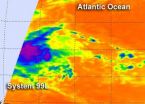Massive data for miniscule communities
2012-08-02
(Press-News.org) EAST LANSING, Mich. — It's relatively easy to collect massive amounts of data on microbes. But the files are so large that it takes days to simply transmit them to other researchers and months to analyze once they are received.
Researchers at Michigan State University have developed a new computational technique, featured in the current issue of the Proceedings of the National Academy of Sciences, that relieves the logjam that these "big data" issues create.
Microbial communities living in soil or the ocean are quite complicated. Their genomic data is easy enough to collect, but their data sets are so big that they actually overwhelm today's computers. C. Titus Brown, MSU assistant professor in bioinformatics, demonstrates a general technique that can be applied on most microbial communities.
The interesting twist is that the team created a solution using small computers, a novel approach considering most bioinformatics research focuses on supercomputers, Brown said.
"To thoroughly examine a gram of soil, we need to generate about 50 terabases of genomic sequence – about 1,000 times more data than generated for the initial human genome project," said Brown, who co-authored on the paper with Jim Tiedje, University Distinguished professor of microbiology and molecular genetics. "That would take about 50 laptops to store that much data. Our paper shows the way to make it work on a much smaller scale."
Analyzing DNA data using traditional computing methods is like trying to eat a large pizza in a single bite. The huge influx of data bogs down computers' memory and causes them to choke. The new method employs a filter that folds the pizza up compactly using a special data structure. This allows computers to nibble at slices of the data and eventually digest the entire sequence. This technique creates a 40-fold decrease in memory requirements, allowing scientists to plow through reams of data without using a supercomputer.
Brown and Tiedje will continue to pursue this line of research, and they are encouraging others to improve upon it as well. The researchers made the complete source code and the ancillary software available to the public to encourage extension.
"We want this program to continue to evolve and improve," Brown said. "In fact, it already has. Other researchers have taken our approach in a new direction and made a better genome assembler."
INFORMATION:
Michigan State University has been working to advance the common good in uncommon ways for more than 150 years. One of the top research universities in the world, MSU focuses its vast resources on creating solutions to some of the world's most pressing challenges, while providing life-changing opportunities to a diverse and inclusive academic community through more than 200 programs of study in 17 degree-granting colleges.
ELSE PRESS RELEASES FROM THIS DATE:
2012-08-02
WEST LAFAYETTE, Ind. - If the drought forces producers to feed a larger portion of distillers dried grains with solubles, cattle can maintain gains and improve meat quality if the animals are weaned early, a Purdue University scientist has shown.
The finding, reported at the American Society of Animal Science Midwest Meetings in Des Moines, Iowa, could allow some producers to save on rising feed costs in the face of this year's drought. Distillers dried grains with solubles, or DDGS, are the leftovers from corn ethanol production. DDGS generally cost about 10 percent ...
2012-08-02
When it comes to intelligence, what factors distinguish the brains of the exceptionally smart from those of average humans?
As science has long suspected, overall brain size matters somewhat, accounting for about 6.7 percent of individual variation in intelligence. More recent research has pinpointed the brain's lateral prefrontal cortex, a region just behind the temple, as a critical hub for high-level mental processing, with activity levels there predicting another 5 percent of variation in individual intelligence.
Now, new research from Washington University in St. ...
2012-08-02
COLUMBIA, Mo. – Infants innately relieve stress by crying, turning their heads or maintaining eye contact. Adults manage emotional tension using problem-solving or by seeking support. A new study by a University of Missouri human development expert describes how adolescents' developing personalities and coping habits affect their behaviors toward others.
"We're each born with some personality tendencies; for example, we see that babies are fussy or calm," said Gustavo Carlo, the Millsap Professor of Diversity in the MU Department of Human Development and Family Studies. ...
2012-08-02
A team of researchers has developed a cheap, rechargeable and eco-friendly battery that could be used to store energy at solar power plants for a rainy day.
Led by Sri Narayan, professor of chemistry at the USC Dornsife College of Letters, Arts and Sciences, the team developed an air-breathing battery that uses the chemical energy generated by the oxidation of iron plates that are exposed to the oxygen in the air – a process similar to rusting.
"Iron is cheap and air is free," Narayan said. "It's the future." Details about the battery will be published July 20 in the ...
2012-08-02
New York, NY and Oxford, UK, August 1, 2012 – The body has a built-in system known as autophagy, or 'self-eating,' that controls how cells live or die. Deregulation of autophagy is linked to the development of human diseases, including neural degeneration and cancer.
In a study published online this week in the Proceedings of the National Academy of Sciences, scientists at the Ludwig Institute for Cancer Research in Oxford discovered a critical molecular switch that regulates autophagy. They also studied the links between autophagy and a cellular process called senescence ...
2012-08-02
Archaeological sites that currently take years to map will be completed in minutes if tests underway in Peru of a new system being developed at Vanderbilt University go well.
The Aurora Flight Sciences unmanned aerial vehicle will be integrated into a larger system that combines the flying device that can fit into a backpack with a software system that can discern an optimal flight pattern and transform the resulting data into three-dimensional maps. The project is an interdisciplinary collaboration between Vanderbilt archaeologist Steven Wernke and engineering professor ...
2012-08-02
A pilot study in adolescents and adults has found that an investigational drug shows promise as the first potential medical treatment for children with the severest type of congenital hyperinsulinism, a rare but potentially devastating disease in which gene mutations cause insulin levels to become dangerously high.
"There is currently no effective medicine for children with the most common and most severe form of hyperinsulinism," said study leader Diva D. De Leon, M.D., a pediatric endocrinologist at The Children's Hospital of Philadelphia. "Our new research shows that ...
2012-08-02
NASA's Aqua satellite spotted some very cold, high, thunderstorms around the center of a tropical low pressure area in the Atlantic Ocean today, indicating that the system is getting stronger and more organized.
The low pressure area, designated as "System 99L" was located about 850 miles east of the southern Windward Islands, near 10.7 North latitude and 46.9 West longitude. It was moving west between 15 and 20 mph.
NASA's Aqua satellite passed over System 99L on August 1 at 0405 UTC (12:05 a.m. EDT) and the Atmospheric Infrared Sounder (AIRS) instrument captured an ...
2012-08-02
Montreal, August 1, 2012 – Caffeine, which is widely consumed around the world in coffee, tea and soft drinks, may help control movement in people suffering from Parkinson's. This is the finding of a study conducted at the Research Institute of the McGill University Health Centre (RI MUHC) that was recently published in Neurology®, the official journal of the American Academy of Neurology. The study opens the door to new treatment options for Parkinson's disease that affects approximately 100 000 Canadians.
"This is one of the first studies to show the benefits of caffeine ...
2012-08-02
Scientists at the Smithsonian and their colleagues have discovered a new mechanism of animal mating plug production. In the giant wood spider Nephila pilipes, a highly sexually dimorphic and polygamous species, many small males compete with one other for access to a few huge females. During copulation these males are known to sever their own genitals in an attempt to plug the female, thereby gaining paternity advantage by preventing other males from mating with her.
Until recently however, nothing has been known about the origin and function of additional and very solid ...
LAST 30 PRESS RELEASES:
[Press-News.org] Massive data for miniscule communities



